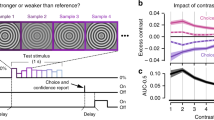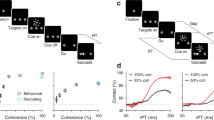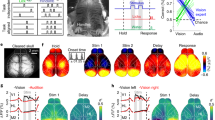Abstract
We often face alternatives that we are free to choose between. Planning movements to select an alternative involves several areas in frontal and parietal cortex1,2,3,4,5,6,7,8,9,10,11 that are anatomically connected into long-range circuits12. These areas must coordinate their activity to select a common movement goal, but how neural circuits make decisions remains poorly understood. Here we simultaneously record from the dorsal premotor area (PMd) in frontal cortex and the parietal reach region (PRR) in parietal cortex to investigate neural circuit mechanisms for decision making. We find that correlations in spike and local field potential (LFP) activity between these areas are greater when monkeys are freely making choices than when they are following instructions. We propose that a decision circuit featuring a sub-population of cells in frontal and parietal cortex may exchange information to coordinate activity between these areas. Cells participating in this decision circuit may influence movement choices by providing a common bias to the selection of movement goals.
This is a preview of subscription content, access via your institution
Access options
Subscribe to this journal
Receive 51 print issues and online access
$199.00 per year
only $3.90 per issue
Buy this article
- Purchase on Springer Link
- Instant access to full article PDF
Prices may be subject to local taxes which are calculated during checkout




Similar content being viewed by others
References
Romo, R. & Schultz, W. Neuronal activity preceding self-initiated or externally timed arm movements in area 6 of monkey cortex. Exp. Brain Res. 67, 656–662 (1987)
Platt, M. L. & Glimcher, P. W. Neural correlates of decision variables in parietal cortex. Nature 400, 233–238 (1999)
Gold, J. I. & Shadlen, M. N. Representation of a perceptual decision in developing oculomotor commands. Nature 404, 390–394 (2000)
Pesaran, B., Pezaris, J. S., Sahani, M., Mitra, P. P. & Andersen, R. A. Temporal structure in neuronal activity during working memory in macaque parietal cortex. Nature Neurosci. 5, 805–811 (2002)
Sugrue, L. P., Corrado, G. S. & Newsome, W. T. Matching behavior and the representation of value in the parietal cortex. Science 304, 1782–1787 (2004)
Cisek, P. & Kalaska, J. F. Neural correlates of reaching decisions in dorsal premotor cortex: specification of multiple direction choices and final selection of action. Neuron 45, 801–814 (2005)
Gail, A. & Andersen, R. A. Neural dynamics in monkey parietal reach region reflect context-specific sensorimotor transformations. J. Neurosci. 26, 9376–9384 (2006)
Pesaran, B., Nelson, M. J. & Andersen, R. A. Dorsal premotor neurons encode the relative position of the hand, eye, and goal during reach planning. Neuron 51, 125–134 (2006)
Quian Quiroga, R., Snyder, L. H., Batista, A. P., Cui, H. & Andersen, R. A. Movement intention is better predicted than attention in the posterior parietal cortex. J. Neurosci. 26, 3615–3620 (2006)
Scherberger, H. & Andersen, R. A. Target selection signals for arm reaching in the posterior parietal cortex. J. Neurosci. 27, 2001–2012 (2007)
Yang, T. & Shadlen, M. N. Probabilistic reasoning by neurons. Nature 447, 1075–1080 (2007)
Johnson, P. B., Ferraina, S., Bianchi, L. & Caminiti, R. Cortical networks for visual reaching: physiological and anatomical organization of frontal and parietal lobe arm regions. Cereb. Cortex 6, 102–119 (1996)
Kreps, D. M. A Course in Microeconomic Theory Ch. 2 (Princeton Univ. Press, Princeton, 1990)
Wise, S. P., Boussaoud, D., Johnson, P. B. & Caminiti, R. Premotor and parietal cortex: corticocortical connectivity and combinatorial computations. Annu. Rev. Neurosci. 20, 25–42 (1997)
Mitzdorf, U. Current source-density method and application in cat cerebral cortex: investigation of evoked potentials and EEG phenomena. Physiol. Rev. 65, 37–100 (1985)
Halliday, D. M. et al. A framework for the analysis of mixed time series/point process data—theory and application to the study of physiological tremor, single motor unit discharges and electromyograms. Prog. Biophys. Mol. Biol. 64, 237–278 (1995)
Bogacz, R., Brown, E., Moehlis, J., Holmes, P. & Cohen, J. D. The physics of optimal decision making: a formal analysis of models of performance in two-alternative forced-choice tasks. Psychol. Rev. 113, 700–765 (2006)
Goldberg, G. Supplementary motor area structure and function: review and hypotheses. Behav. Brain Sci. 8, 567–616 (1985)
Kerns, J. G. et al. Anterior cingulate conflict monitoring and adjustments in control. Science 303, 1023–1026 (2004)
Daw, N. D. & Doya, K. The computational neurobiology of learning and reward. Curr. Opin. Neurobiol. 16, 199–204 (2006)
Schmolesky, M. T. et al. Signal timing across the macaque visual system. J. Neurophysiol. 79, 3272–3278 (1998)
Cisek, P. Integrated neural processes for defining potential actions and deciding between them: a computational model. J. Neurosci. 26, 9761–9770 (2006)
Bressler, S. L., Coppola, R. & Nakamura, R. Episodic multiregional cortical coherence at multiple frequencies during visual task-performance. Nature 366, 153–156 (1993)
Murthy, V. N. & Fetz, E. E. Synchronization of neurons during local field potential oscillations in sensorimotor cortex of awake monkeys. J. Neurophysiol. 76, 3968–3982 (1996)
Riehle, A., Grun, S., Diesmann, M. & Aertsen, A. Spike synchronization and rate modulation differentially involved in motor cortical function. Science 278, 1950–1953 (1997)
Scherberger, H., Jarvis, M. J. R. & Andersen, R. A. Cortical local field potential encodes movement intentions. Neuron 46, 347–354 (2005)
Rickert, J. et al. Encoding of movement direction in different frequency ranges of motor cortical local field potentials. J. Neurosci. 25, 8815–8824 (2005)
Buschman, T. J. & Miller, E. K. Top-down versus bottom-up control of attention in the prefrontal and posterior parietal cortices. Science 315, 1860–1862 (2007)
Fries, P. A mechanism for cognitive dynamics: neuronal communication through neuronal coherence. Trends Cogn. Sci. 9, 474–480 (2005)
Mitra, P. P. & Pesaran, B. Analysis of dynamic brain imaging data. Biophys. J. 76, 691–708 (1999)
Acknowledgements
This work was supported by the National Eye Institute, the National Institute of Mental Health, the Defense Advanced Research Projects Agency BioInfoMicro program, a Career Award in the Biomedical Sciences from the Burroughs Wellcome Fund (B.P.), a James D. Watson Investigator Program Award from NYSTAR (B.P.) and a Sloan Research Fellowship (B.P.). We thank: N. Daw, H. Dean and D. Heeger for comments; T. Yao for editorial assistance; K. Pejsa and N. Sammons for animal care; and V. Shcherbatyuk and M. Walsh for technical assistance.
Author Contributions B.P., M.J.N. and R.A.A. designed the experiment and wrote the paper. B.P. and M.J.N. collected the data. B.P. performed the data analysis.
Author information
Authors and Affiliations
Corresponding author
Supplementary information
Supplementary information
The file contains Supplementary Methods; Supplementary Results; Supplementary Discussion; Supplementary References; Supplementary Figures 1-10 and Legends and Supplementary Tables 1-2 (PDF 2997 kb)
Rights and permissions
About this article
Cite this article
Pesaran, B., Nelson, M. & Andersen, R. Free choice activates a decision circuit between frontal and parietal cortex. Nature 453, 406–409 (2008). https://doi.org/10.1038/nature06849
Received:
Accepted:
Published:
Issue Date:
DOI: https://doi.org/10.1038/nature06849
This article is cited by
-
Ramping dynamics and theta oscillations reflect dissociable signatures during rule-guided human behavior
Nature Communications (2024)
-
Characteristics of corticomuscular coupling during wheelchair Tai Chi in patients with spinal cord injury
Journal of NeuroEngineering and Rehabilitation (2023)
-
Paranormal believers show reduced resting EEG beta band oscillations and inhibitory control than skeptics
Scientific Reports (2023)
-
Cortical Mechanisms of Multisensory Linear Self-motion Perception
Neuroscience Bulletin (2023)
-
Modulation of inhibitory communication coordinates looking and reaching
Nature (2022)
Comments
By submitting a comment you agree to abide by our Terms and Community Guidelines. If you find something abusive or that does not comply with our terms or guidelines please flag it as inappropriate.



